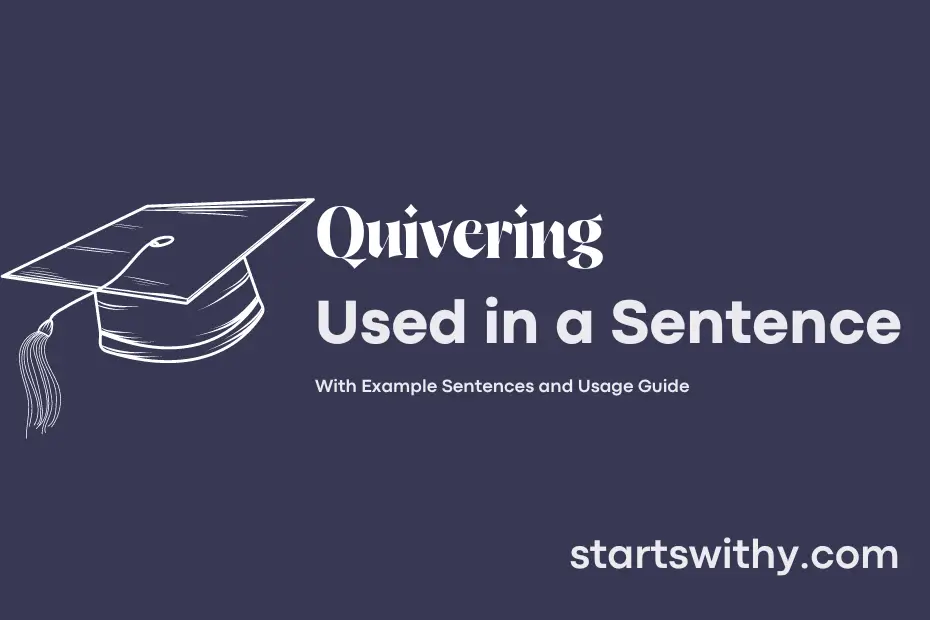Quivering, the act of shaking or trembling involuntarily, is a physical response often triggered by fear, excitement, or cold. It manifests as a rapid, trembling movement that can be subtle or pronounced depending on the intensity of the emotion or stimulus.
In writing, a quivering example sentence vividly captures the emotion or atmosphere of a scene, effectively conveying a sense of tension, anticipation, or unease to the reader. This type of sentence carries a palpable energy, engaging the reader and immersing them in the narrative.
7 Examples Of Quivering Used In a Sentence For Kids
- The little rabbit was quivering with fear in the forest.
- The leaves on the tree were quivering in the gentle breeze.
- The small mouse was quivering as it peeked out of its hole.
- The butterfly’s wings were quivering as it danced in the garden.
- The baby bird was quivering with excitement as it learned to fly.
- The squirrel’s tail was quivering as it collected nuts for winter.
- The cat’s whiskers were quivering as it stalked a butterfly.
14 Sentences with Quivering Examples
- The college student sat in quivering anticipation as the professor handed back their exam papers.
- As the group presentation began, a quivering nervousness spread through the college student’s body.
- Quivering with excitement, the college student signed up for a study abroad program in Europe.
- Quivering with fear, the college student approached their crush to ask them out on a date.
- The college student’s hands were quivering as they waited to give a speech in front of their classmates.
- The college student’s heart was quivering with anxiety as they waited for the results of their internship application.
- Quivering with adrenaline, the college student prepared for a solo dance performance at the cultural festival.
- Standing at the edge of the cliff during a college hiking trip, the student felt their legs go quivering with excitement and fear.
- The college student’s voice was quivering as they tried to defend their research project during a heated debate.
- Quivering with pride, the college student proudly displayed their art project at the campus exhibition.
- The college student’s fingers were quivering with anticipation as they clicked submit on their final assignment.
- Quivering with determination, the college student pushed themselves to finish their thesis before the deadline.
- The college student’s knees were quivering as they nervously waited for the results of their scholarship application.
- Watching the sunrise from their college dorm room window, the student felt a peaceful quivering in their heart.
How To Use Quivering in Sentences?
To use the word Quivering in a sentence, you should first understand its meaning. Quivering means to shake or tremble with a slight, rapid motion.
Here are some examples to help you properly use the word Quivering in a sentence:
- The little puppy was quivering with excitement when its owner arrived home.
- She felt her hands begin to quiver with nervousness as she stepped onto the stage.
- The leaves on the trees were quivering in the gentle breeze.
- His voice was quivering with emotion as he delivered the heartfelt speech.
- The deer stood in the clearing, quivering with fear at the sound of nearby footsteps.
When using Quivering in a sentence, remember to pay attention to the context in which you are using it. Quivering is often associated with emotions like fear, excitement, nervousness, or intensity. It is commonly used to describe physical movements or reactions that involve a slight shaking or trembling motion.
By following these examples and understanding the meaning of the word Quivering, you can use it effectively in your sentences to accurately convey a sense of trembling or shaking.
Conclusion
In conclusion, sentences with “quivering” serve to evoke a sense of unsteadiness, fear, or excitement in the reader. These sentences often describe trembling movements or emotions that add depth and intensity to the narrative. Through the use of “quivering,” authors can create a vivid and immersive experience for the audience, allowing them to connect with the characters’ internal struggles and external challenges on a deeper level.
By incorporating “quivering” into their writing, authors can convey a wide range of emotions and physical sensations effectively. Whether it’s a character’s voice quivering with fear or a leaf quivering in the wind, these sentences can bring scenes to life and engage readers on an emotional level. Overall, sentences with “quivering” add texture and complexity to the writing, enriching the storytelling experience and leaving a lasting impact on the audience.



